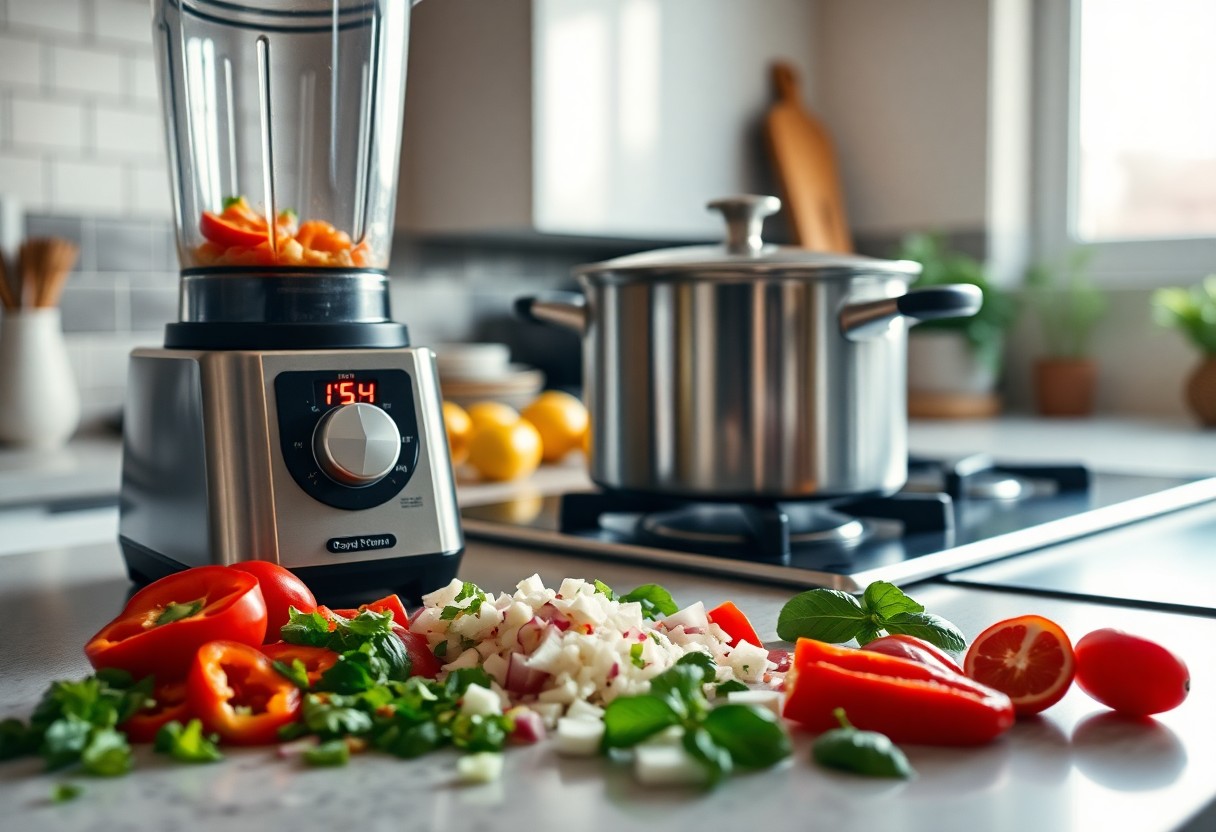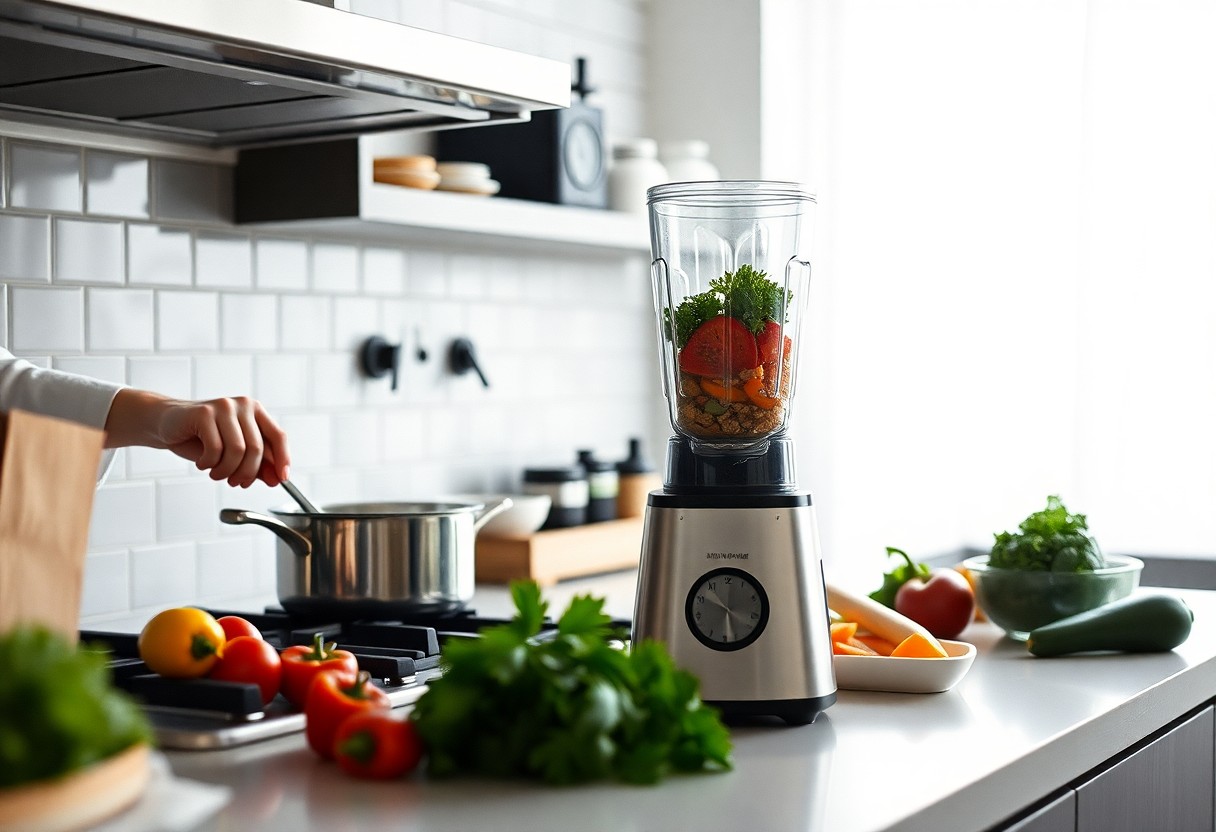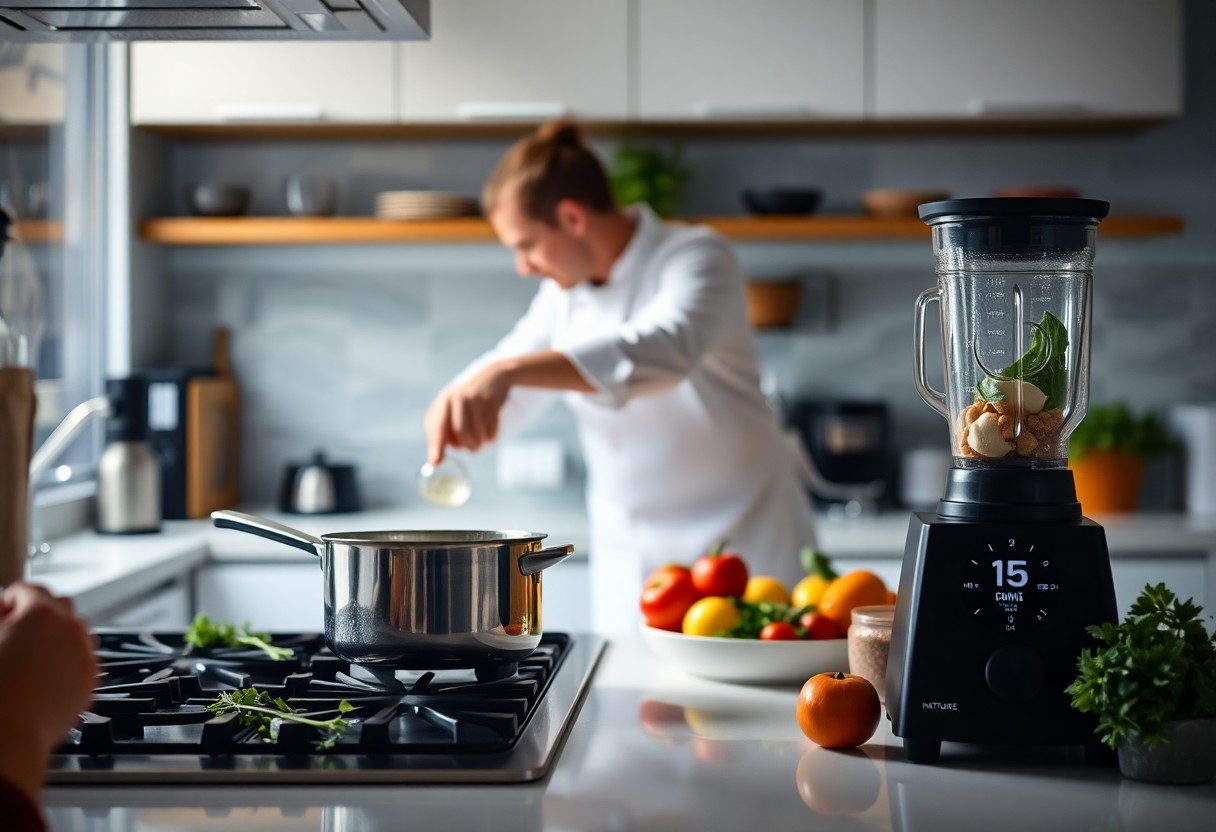Many home cooks underestimate the power of multitasking in the kitchen. By blending and cooking simultaneously, you can streamline your meal prep, cutting your cooking time by as much as 15 minutes. This technique not only increases your efficiency but also allows you to manage your time better, leaving you with less cleanup and more time to enjoy your meal. You’ll find that mastering this skill can transform your cooking routine, making it a game-changer for busy weeknights.

Key Takeaways:
- Combining blending with cooking helps streamline meal preparation, allowing for multiple tasks to be completed simultaneously.
- By preparing ingredients in a blender while certain components are cooking, you minimize idle time and keep the cooking process efficient.
- This multitasking approach not only saves time but can also enhance flavor by allowing fresh ingredients to be incorporated just as they finish cooking.

The Multitasking Miracle: Cooking and Blending in Tandem
Successfully blending and cooking at the same time allows you to streamline your kitchen processes and maximize your efficiency. By organizing these tasks, you can keep your kitchen flowing and produce meals more effectively. You’re not just saving time; you’re also enhancing the flavors of your dishes. When you multitask carefully, each step harmonizes, allowing you to create complex meals without the headache of a packed schedule.
The Science of Simultaneous Processes
The concept of overlapping tasks is grounded in cognitive psychology. Our brains are wired to handle multiple processes simultaneously, especially if they’re well-rehearsed. Engaging in two supportive activities, like blending and cooking, can lead to increased productivity as long as they don’t require your full attention individually. This synergy means you’re not just economizing time but also capitalizing on sensory experiences, enhancing both aroma and taste as different flavors meld together.
Time-Saving Techniques to Maximize Efficiency
Implementing specific techniques while blending and cooking can remarkably enhance your efficiency. For instance, start with the most time-consuming items, like chopping vegetables, while your blender works on sauces or dressings. Organizing your workspace intelligently, using multi-tasking appliances, and preparing in bulk can further save precious minutes. Practicing these methods not only accelerates the cooking experience but also elevates your culinary skills over time.
To maximize efficiency, prep ingredients in advance. Chop, measure, and portion items during your weekly meal prep sessions, allowing for quick access during cooking. Utilize your blender not only for smoothies but also for sauces, soups, and marinades that can simmer while you handle other cooking tasks. Timing your operations so that you’re blending while a pot is boiling creates a seamless workflow. This approach ultimately reduces idle time and enhances your overall kitchen experience, bringing you closer to that desired 15-minute saving.
Recipe Strategies That Leverage Overlapping Tasks
Strategically planning your recipes can significantly enhance your efficiency in the kitchen. Think about how you can combine cooking methods and save time. For instance, layering flavors is a powerful technique; you can sauté vegetables for a soup while puréeing a sauce for a pasta dish. By intertwining these steps, you’ll minimize the time spent on each individual task, ultimately allowing you to serve your meals faster while enhancing the taste.
One-Pot Wonders: Streamlining Cooking Methods
One-pot meals are ideal for reducing cleanup time and maximizing flavor. Dishes like risotto or frittatas can incorporate ingredients as they cook, allowing you to toss in veggies, protein, and grains all into one pot. While the main dish simmers, you can blend sauces or dressings that will elevate your meal, making the entire process seamless and quick.
Blending While Boiling: Timing Techniques
Blending while boiling requires careful timing to achieve optimal results. For example, if you’re cooking pasta, start blending your sauce as the pasta begins to soften. This method not only ensures that both components are ready at the same time but also allows the flavors to meld beautifully. By utilizing a timer, you can ensure that your sauce is ready just as the pasta reaches al dente, leading to a deliciously coordinated dish without wasting any precious minutes.
With this technique, you’ll find that blending sauces or even pureeing ingredients during the boiling phase can create a scrumptious synergy. By estimating the timing accurately, you can whip up a rich, velvety sauce in the blender as you monitor and strain your pasta. If you’re boiling vegetables, they can be blended into a smooth soup while keeping an eye on the pot. This multitasking not only saves you time but also enriches your meals with fresh, homemade flavors that are sure to impress.
The Time Reclamation: A Day in the Life
Imagine walking through your typical day, juggling work, family, and personal commitments. You wake up, prepare breakfast while multitasking on emails, and then probe the chaos of your schedule. By embracing the concept of blending and cooking simultaneously, you can seize precious minutes throughout the day. This approach transforms how you manage your time, allowing you to reclaim those lost moments and incorporate them back into your routine.
Real-Life Application: Meal Prep Scenarios
Applying this technique in a real-life scenario might involve making a smoothie while your eggs are scrambling on the stove. You might also puree vegetables for a sauce as you sauté protein, which can lead to flavorful dishes without sacrificing time. By thinking creatively and planning ahead, you can seamlessly integrate blending into your meals, turning an ordinary cooking session into an efficient powerhouse of productivity.
Quantifying Minutes Saved: A Practical Breakdown
On a practical level, you can save up to 15 minutes during meal preparation by blending and cooking at the same time. For instance, if you prepare a salad dressing while your chicken is marinating, you’re optimizing your use of time. Consider this: prepping ingredients can take upwards of 30 minutes, but by leveraging multitasking techniques, you can cut that time in half.
The time savings compound throughout the week. For example, if each meal prep session saves you 15 minutes, that amounts to over an hour saved for a week of cooking. This breakthrough optimizes not just the time spent in the kitchen but enhances your overall efficiency. By planning meals that support simultaneous actions—like prepping a smoothie mixer while your grains simmer—plus the incorporation of strategically timed techniques, you can unlock even greater savings, reinforcing the value of every minute during those hectic days.
Beyond the Kitchen: Transferring Skills to Daily Life
Maximizing efficiency in the kitchen offers lessons that extend far beyond meal prep. Incorporating multitasking into your daily routine can streamline other activities, enhancing your overall productivity. By applying the same principles of simultaneous work, you can effectively manage personal and professional tasks, making room for leisure and self-care. Whether it’s finishing a report while waiting for the laundry to finish or responding to emails on your commute, these strategies can create substantial time savings in all areas of your life.
The Broader Implications of Effective Multitasking
Effective multitasking reshapes how you approach daily responsibilities, allowing you to tackle several tasks at once without sacrificing quality. Engaging in this practice can lead to improved concentration and better time management skills. Allowing multiple tasks to be completed simultaneously not only gives you more time but also elevates your overall productivity.
Building a Habit of Efficiency in Routine Tasks
Integrating multitasking techniques into daily habits fosters a culture of efficiency in your life. Instead of viewing each task as distinct and separate, merge them where possible. You might check emails while brewing your morning coffee or fold laundry while catching up on a podcast. These strategies can help you develop a mindset that prioritizes time optimization and smooths the flow of your day.
Adopting a habit of efficiency involves actively seeking opportunities for overlap in your tasks. Set specific combos you can turn into routines, such as meal prepping during your favorite show or exercising while the kids complete their homework. By establishing these practices, you transition from a reactive to a proactive approach, enabling you to complete important tasks without overwhelming your schedule. Over time, you’ll find that these small changes compound into significant time savings, dramatically enhancing your quality of life.
Common Pitfalls to Avoid When Blending and Cooking
Balancing blending and cooking can streamline your culinary efforts, but common missteps can derail your efficiency. Keeping a close eye on timing, utilizing the right tools, and preparing your ingredients can make all the difference between a perfect meal and a frustrating experience. Avoid these pitfalls to ensure that your multitasking efforts yield delicious and satisfying results.
Miscalculating Time: Keeping Food from Overcooking
Overcooking is a frequent hazard when you’re focused on blending while cooking. Each task requires your attention, making it easy to lose track of time. To combat this, set a timer for each component of your meal. This way, you can maintain a steady rhythm, ensuring that cooked ingredients retain their desired texture and flavor without succumbing to prolonged exposure to heat.
Tool Management: Choosing the Right Equipment
Selecting appropriate kitchen tools directly influences your blending and cooking success. Invest in a quality immersion blender, for example, which allows you to blend sauces or soups directly in the pot — saving you an extra dish and minimizing cleanup time. You should also have a reliable set of measuring cups and spoons easily accessible to avoid fumbling for ingredients mid-recipe. Combining these two elements can greatly enhance both your efficiency and cooking accuracy.
Starting with the right tools can streamline your process and elevate the outcome of your dishes. Opt for versatile equipment like a multi-functional food processor that can chop, grate, and blend, cutting down on tasks. Having a dedicated space for utensils and appliances also helps you avoid wasting time searching for them. By ensuring that your kitchen is stocked with efficient, high-quality tools, you set yourself up for a smoother and more enjoyable cooking experience.
Final Words
To wrap up, blending and cooking simultaneously can significantly streamline your meal prep, shaving off up to 15 minutes from your kitchen time. By multitasking these two processes, you maximize efficiency, allowing you to chop ingredients while your dish cooks, or even create dressings and sauces during the cooking process. This not only enhances your overall productivity but also keeps flavors fresh and vibrant in your meals. Implementing this technique into your cooking routine can transform your approach, making home-cooked meals quicker and more enjoyable.
FAQ
Q: How does blending while cooking help reduce cooking time?
A: Combining the processes of blending and cooking allows for more efficient use of time and resources in the kitchen. While ingredients are heating or simmering, you can blend soups or sauces simultaneously. This multitasking means you’re not waiting for one step to finish before starting another, effectively condensing the overall cooking time.
Q: Can blending ingredients during cooking improve the texture and flavor of the dish?
A: Yes, blending ingredients at the right moment can enhance the texture and flavor profile of your dishes. For instance, while sautéing vegetables, you can prepare a creamy sauce or puree in a blender. By the time the vegetables are cooked to your liking, the sauce may be ready to be combined with them, ensuring that the flavors meld beautifully and providing a rich, cohesive dish without extra waiting time.
Q: Are there specific recipes that benefit from blending and cooking simultaneously?
A: Indeed, numerous recipes benefit from this technique. Examples include smoothies that incorporate partially cooked components like roasted fruits or vegetables, or creamy soups that require blending once the ingredients are tender. Dishes like marinades or dressings can also be blended while proteins are cooking, saving you additional steps while enhancing the overall quality of your meal.
